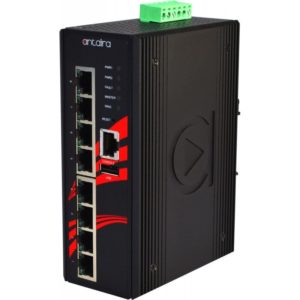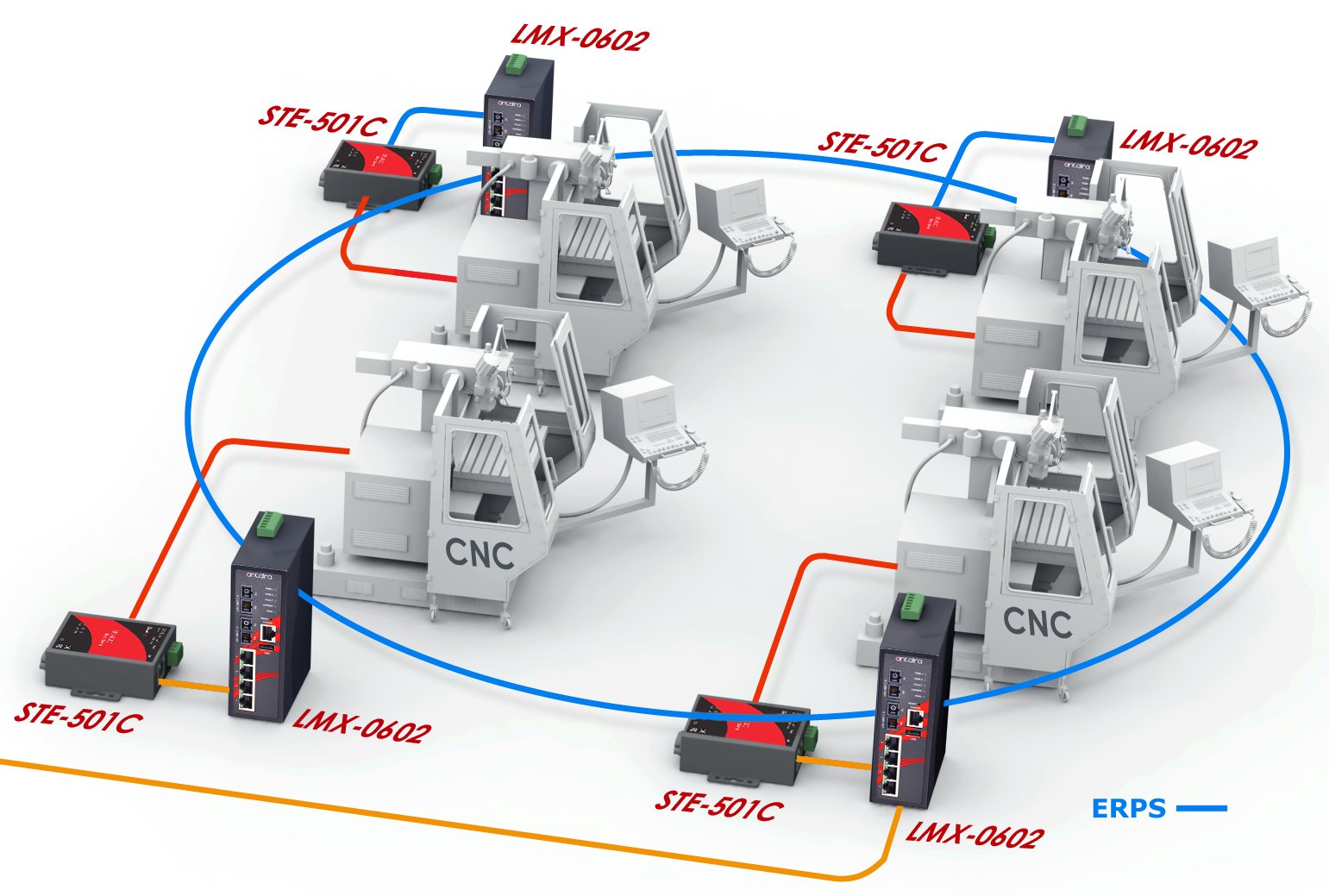Industrial networks have many demands, and one of the principle rules is that downtime isunacceptable. With the myriad design elements available, it can be difficult to pinpoint which is best for your industry. If Ethernet plays a major role in your network infrastructure, then ERPS might be the most cost-effective way to add redundancy and up-time protection to any network, regardless of size and traffic.
What Is ERPS?
Ethernet Ring Protection Switching (ERPS) is a standardized approach to network design. It enables large amounts of Ethernet traffic to flow to multiple connection points with high-level redundancy. There are several ways to implement ring networking topographies, but with Ethernet, ITU-T G.8032 is the gold standard. When used correctly, G.8032 management protects Ethernet traffic and maintains recovery times under 50 milliseconds (ms).
The concept behind the design is pretty simple. Network nodes are connected in rings, or closed loops. Subsequent rings are connected to each other by joining two nodes from each. This redundancy is what enables the fast network recovery when any single point fails. Ring constructs alone aren’t enough for stable networking as the design is prone to looping. Without protocol to prevent it, any data packet could circle a ring endlessly and eat precious bandwidth.
G.8032 prevents looping by actively managing traffic. When everything is working nominally, the protocol blocks traffic on a single ring link to prevent looping. If a node fails, the protocol reroutes traffic (opening the closed link as needed) to keep data flowing. When the failed node is restored, the protocol automatically closes the temporary link to continue protecting against data loops.
Where Should You Use It?
Considering the equipment involved, focus on minimizing downtime and overall design and implementation of G.8032, it carries some obvious advantages for certain industries. Any work where downtime of even a few seconds can be critical is best suited by ERPS. It also serves well in networks that require frequent changes to design or are ill suited for the expenses of fiber optic networking. ESRP rings can be integrated into existing networks; the standardization behind G.8032 makes it easy to add network rings ad hoc without destabilizing any existing design. Some of the most common industries that utilize G.8032 are mining; waste management; gas, power and utility monitoring; automated production facilities; surveillance and security; safety monitoring and harsh-environment workplaces.
Comparing Ring Protocols
So far, we’ve covered some of the basics of G.8032 networking protocol and where it shines. In this section we’ll delve a little deeper and compare G.8032 to common alternatives. Then, we’ll discuss the principles of designing a network around ERPS concepts.
An exhaustive list of protocols could get pretty long, but the three most common in Ethernet networks are ERPS, MSTP (802.1s) and RSTP (802.1w). Keep in mind that optical solutions like SONET and SDH can be used with fiber optics, but those go beyond the scope of this discussion. With that, here is a quick comparison of the pros and cons of the three most common protocols.
RSTP
RSTP, or Rapid Spanning Tree Protocol, is a faster version of one of the older methods of building mesh networks. RSTP enables Ethernet networks to link together in a redundant fashion. Its biggest limitation is in recovery time. The methodology that allows RSTP configurations to detect and respond to a failed link can take anywhere from 2 to 10 seconds. A second shortcoming of RSTP is in network size limitations. The protocol can handle a maximum of seven hops, and this can force larger networks to implement extra hardware as they scale upwards.
MSTP
Multiple Spanning Tree Protocol trades the slightly faster convergence times of RSTP for the ability to map multiple VLANs on a single set of equipment. This allows for intricate network isolation and can potentially save on hardware costs. Its biggest drawback is 10-second convergence times. Otherwise, it provides economical, redundant networking.
ERPS
ERPS has a few distinct advantages over the other two. The most obvious is convergence time. Beyond that, the G.8032 protocol is the most universal of the three, and it is available on a wider range of hardware. The universal nature makes it easier to add to existing networks, and the faster redundancy ultimately gives it larger scalability. There is no theoretical limit on the number of rings that can be added to a network. So as long as you have sufficient bandwidth, you can keep adding nodes.
Network failover technologies like ERPS and spanning tree will redirect traffic in the case of link failure and may be configured on any data port in the switch, not just fiber ports. However, one noticeable difference between ERPS and spanning tree is the design, where ERPS forms a ring while spanning tree can also be configured in a mesh-style network.
Designing ESRP Networks
While networks can easily become large and complicated, the principles of ESRP design are straightforward. The network will consist of a ring and any connected subrings. Once a main ring is established, subrings can be added ad hoc. This video shows how easy it is to start a ladder configuration with unlimited expandability. ERPS creates virtual circuits that interconnect switches together. These circuits are point-to-point links that reference their peer’s mac-address.
In any given ring, G.8032 will manage traffic by establishing an owner and a neighbor node. The owner dictates traffic, and it is responsible for closing the RPL (ring protection link). The RPL is essentially a closed link of traffic that prevents looping. If a link fails, the owner opens the RPL until service is restored. When the failure is resolved, the owner will automatically close the RPL and traffic will continue to flow uninterrupted.

With this in mind, design options are diverse, but they come with trade-offs. A ladder configuration has the most redundancy, but it doesn’t allow for much network isolation. Since each ring only has two nodes, there isn’t much opportunity to segregate networks as you might need. You can move away from a ladder configuration and make larger rings, creating physical or virtual LANs with isolated traffic, but there is a risk. Every node added between rings increases the chance of multiple failure points, which can lead to downtime.
Exploring the virtues of ERPS is pretty easy, and decisions get even easier when you consider specific equipment. Devices like the Antaira LMX-0800G and the rest of our managed line come preconfigured for ERPS and other ring redundancy protocols.
 Antaira ERPS Network
Antaira ERPS Network
how owner port is selected in ERPS?
You can set up the ERPS owner port of an Antaira managed switch in the GUI setup menu. See the section highlighted in red: